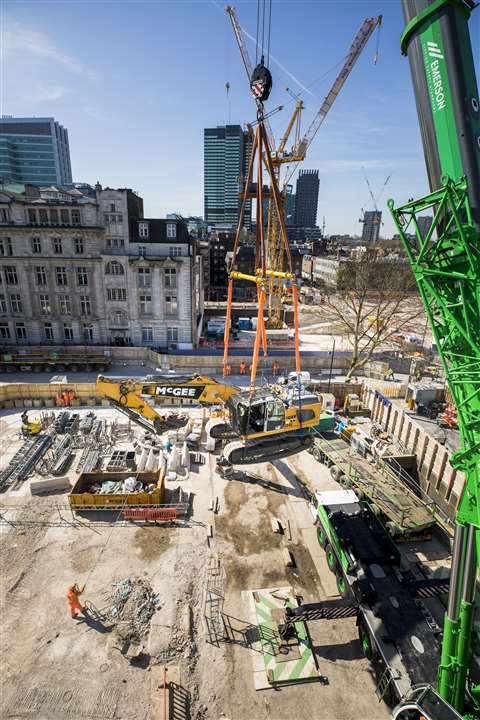Infrastructure’s technology testbeds
15 November 2021
Mark Sugden of Withers & Rogers looks at why so many construction innovations are first tested on mega projects
 Construction work on the HS2 rail project in Euston, London. Image courtesy HS2, www.johnzammit.co.uk and Absolute Photography
Construction work on the HS2 rail project in Euston, London. Image courtesy HS2, www.johnzammit.co.uk and Absolute Photography
For innovators in the construction industry, mega projects such as HS2 provide a great testing ground for technology that aims to improve building processes, particularly highly technical construction work.
As well as providing the potential to reduce costs and improve efficiency, innovations in the construction sector can also lower emissions, something that is particularly important with net zero on the horizon.
Given the scale of mega projects, and their importance to the UK’s infrastructure, it’s vital that they are delivered as efficiently as possible.
To ensure this happens, continuous innovation is necessary, whether it be through new processes, materials or equipment.
The complex nature of these types of projects means they’re likely to encounter problems that are unique to them, but this doesn’t mean that the solutions created cannot be applied to smaller-scale projects too.
Many industries use major events as a reason to boost innovation activity, for example the sports sector often becomes more active around the Olympics, and construction is no different.
Budgets for mega projects tend to be high, with a focus on R&D activity, allowing new processes and materials to be developed and tested. As net zero approaches, the need to innovate is becoming increasingly pressing.
New dimension for concrete
Each of the following three innovations is being tested on HS2. The first is graphene-reinforced 3D-printed concrete, which is being used on HS2’s London tunnels. Also known as ‘Printfrastructure’, this 3D printing technology will help to cut carbon on the project by up to 50%.
 Mark Sugden of Withers & Rogers
Mark Sugden of Withers & Rogers
Developed by ChangeMaker 3D and Versarien, the process involves 3D printing the concrete structure with microscopic strands of graphene running through it.
Replacing traditional steel with graphene simplifies the construction process, removing the need for cranes and – as it can be produced on-site – considerably reducing the need for delivery trucks, lowering carbon emissions.
In addition, being able to print the concrete with an internal lattice structure cuts waste and lowers the quantity of concrete required, providing further environmental benefits.
Winds of change
The second is an HS2 pilot project, which is swapping steel for retired glass fibre wind turbine blades to reinforce concrete. Wind turbine blades are notoriously difficult to recycle, so this solution offers a way to reuse the blades, without having to break them down.
The project is being implemented by Skanska Costain Strabag Joint Venture (SCS JV), and the National Composites Centre, with the process holding the potential to cut carbon production by up to 90%.
The third is a vacuum excavation technique for piling that is also being trialled on the HS2 project.
Less excess, more success
SCS JV worked alongside Cementation Skanska to design the method, with Hercules Site Services developing the technology and providing a machine for use on-site in the Euston Approaches.
The ‘zero trim pile technique’ involves excess concrete being sucked out while wet using a vacuum excavator.
As well as using less concrete, this technique can also reduce the chance of health problems for workers. Traditional piling techniques require workers to break out the excess concrete once it has hardened, potentially leading to hand-arm vibration syndrome, hearing loss and silicosis. Removing the excess before it sets means this is no longer a risk.
Protecting R&D investments
These innovations, and others developed on mega projects, could massively benefit the construction industry in general. Therefore, it’s vital for innovators to consider patent protection from an early stage in order to stop copycats from using the techniques created for their own commercial gain.
Patent protection provides 20 years of exclusivity rights, giving them a considerable advantage over their competitors. If an innovation gets into the headlines, as many do on projects in the public eye, then it’s likely that other companies within the sector will want to invest in the technology as well.
Only the patent owner can offer it to these companies, enabling them to reap the commercial rewards of their R&D activity.
A constant need for efficiency, and the approach of net zero, means innovation is more essential than ever on mega projects.
For those that successfully develop techniques that could revolutionise the construction industry, seeking patent protection early on is vital to making the most of their innovations.
|
About the author Mark Sugden is a senior associate in the Advanced Engineering Group at European intellectual property firm, Withers & Rogers. |
STAY CONNECTED



Receive the information you need when you need it through our world-leading magazines, newsletters and daily briefings.
CONNECT WITH THE TEAM








